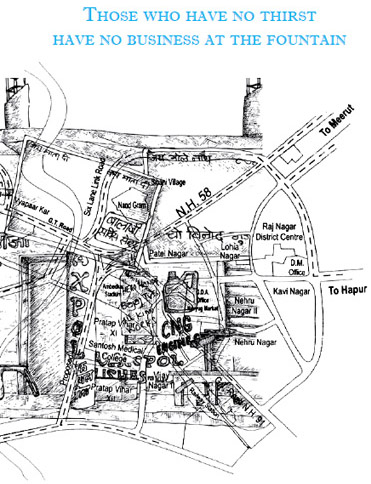

The boundaries of urban areas across India are rapidly expanding. Peri-urban cities are mushrooming on their peripheries, as next in line contenders for mega metros. Slums and resettlement colonies share boundaries with premium multi-rises. Planned layouts, industries, and commercial
spaces dot the urban skyscape. Though diverse in composition, one common need threads them together – the need for regular access to clean water.
My graphic novel, “The Water Cookbook” is based on the uncertainties of availability of drinking water and the situations that arise because of this in an area which lies right beside a river. A short description of the area is below.
In the National Capital Territory, in the trans-Hindon region (West of the River Hindon, East of the Yamuna river) is the area of Ghaziabad district. Hindon river starts in Saharanpur district in the lower Himalayas. It’s tributaries including the Kali River (West), and the Krishni River. It
flows between Ganges and Yamuna rivers, for 400 km through Muzaffarnagar District, Meerut District, Baghpat District, Ghaziabad, Noida, Greater Noida before it joins Yamuna river just outside Delhi. A highly populated and predominantly rural catchment, the Hindon River is heavily utilized as a water
resource for domestic, agricultural and industrial uses, while untreated groundwater is the primary source of drinking water.
Here there is access to water from different sources and of varying quality. Water is supplied through the Ganga Water Project, but only to privileged areas under the Ghaziabad Development Authority and Awas Vikas scheme. Ganges water is not supplied to the villages and informal settlements in these
areas. Some of the outstanding areas have water supplied to them from the reservoir near the Tila Mor in the Cis-Hindon (East of the river Hindon) part of the city based on
underground sources from a tubewell water supply scheme. The Trans-Hindon region also includes several rural areas that have been converted to urban areas in the past three years. These have no piped water supply and residents rely on a limited number of hand pumps installed by the inhabitants themselves.
Citizens in the trans-Hindon area are subjected to many of the difficulties that are characteristic of peri-urban areas. Major water supply schemes are in progress for the area, with large engineering projects, but are only planned for the authorized colonies and new developments. Citizens concerns
include limited availability of good quality drinking water, difficulties with wastewater disposal and a prevalence of skin diseases.